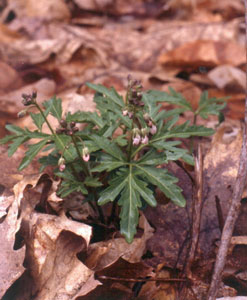DACF Home → Bureaus & Programs → Maine Natural Areas Program → Communities, Plants, and Animals → Rare Plants → Cardamine concatenata
Cardamine concatenata (Michx.) Sw.

Cut-leaved Toothwort
- State Rank: S1
- Global Rank: G5
- State Status: Endangered
Habitat: Rich woods, wooded bottoms and calcareous rocky banks. [Hardwood to mixed forest (forest, upland)]
Range: Quebec to Florida, west to Minnesota, Nebraska, Kansas, Texas.
Aids to Identification: Cut-leaved toothwort bears several white or pink 4 petalled flowers in a loose terminal cluster. It is distinguished from other toothworts by its 3 whorled stem leaves, which are deeply palmately divided. The dissection of these leaves is extremely variable. It has no basal leaves at flowering time. The upper stem is downy.
Ecological characteristics: Like spring beauty (Claytonia caroliniana) and trout lily (Erythronium americanum) with which it is often found, cut-leaved toothwort is a spring ephemeral, blooming in early spring when the light reaching the hardwood forest floor is at its maximum, and withering by early June. Apparently it reproduces vegetatively by means of jointed rhizomes and may occur in large clonal patches. At its single known Maine station (1983) it dominates the spring herb community on a beech-maple-oak forested, south-facing hillside.
Phenology: Flowers in early spring, leaves die back by early summer. A perennial.
Family: Brassicaceae
Synonyms: Cardamine laciniata (Muhl. ex Willd.) Wood; Dentaria concatenata Michx.; Dentaria laciniata Muhl. ex Willd.
Known Distribution in Maine: This rare plant has been documented from a total of 1 town(s) in the following county(ies): Aroostook.
Reason(s) for rarity: Unknown. The single Maine station is large and well-established.
Conservation considerations: Effects of logging are unknown, but partial removal of the canopy would be less likely to adversely affect the plant than complete removal.